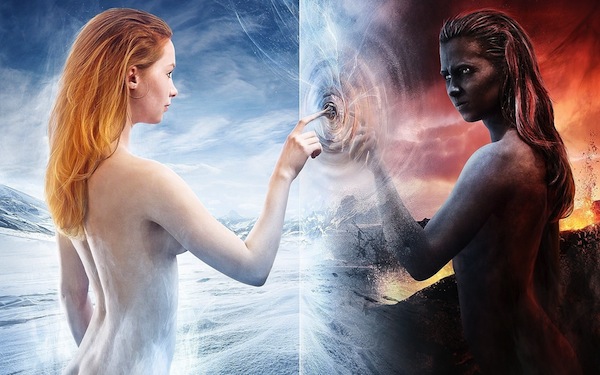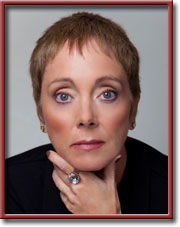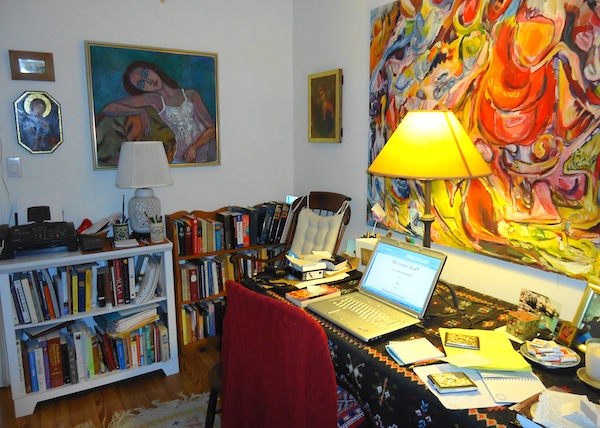My Late, Great Bipolar Friend: A Sphere in Flatland
“I actually prefer the old term, ‘manic depression,’ to the new term for what Sally dealt with: bipolar disorder. Bipolar disorder sounds like something tetchy and small; something amiss amongst the spark plugs; something manageable with hand tools. Disorder. What Sally dealt with was no ‘disorder.’ Her grey matter was not in slight disarray. Her software did not need—ah, there—a quick rebooting.” Elizabeth Boleman-Herring
Ruminant With A View
By Elizabeth Boleman-Herring

“It was as if my father had given me, by way of temperament, an impossibly wild, dark, and unbroken horse. It was a horse without a name, and a horse with no experience of a bit between its teeth. My mother taught me to gentle it; gave me the discipline and love to break it; and—as Alexander had known so intuitively with Bucephalus—she understood, and taught me, that the beast was best handled by turning it toward the sun.”—Kay Redfield Jamison, An Unquiet Mind: A Memoir of Moods and Madness
“Compared to bipolar’s magic, reality seems a raw deal. It’s not just the boredom that makes recovery so difficult, it’s the slow dawning pain that comes with sanity—the realization of illness, the humiliating scenes, the blown money and friendships and confidence. Depression seems almost inevitable. The pendulum swings back from transcendence in shards, a bloody, dangerous mess. Crazy high is better than crazy low. So we gamble, dump the pills, and stick it to the control freaks and doctors. They don’t understand, we say. They just don’t get it. They’ll never be artists . . . . It’s difficult. I take a low dose of lithium nightly. I take an antidepressant for my darkness because prayer isn’t enough. My therapist hears confession twice a month, my shrink delivers the host, and I can stand in the woods and see the world spark.”—David Lovelace, Scattershot: My Bipolar Family
 TEANECK New Jersey—(Weekly Hubris)—9/16/2013—Maurice Sendak (1928—2012), in Where The Wild Things Are, wrote: “There should be a place where only the things you want to happen, happen.”
TEANECK New Jersey—(Weekly Hubris)—9/16/2013—Maurice Sendak (1928—2012), in Where The Wild Things Are, wrote: “There should be a place where only the things you want to happen, happen.”
And, of course, in that place, author and illustrator and magician-of-life Maurice Sendak, who died a few months before my friend, South Carolina painter Sally O’Reilly (not her actual name), would be alive and well, his crotchety, irascible, decrepit old self, still giving Stephen Colbert a run for his money, and still dreaming up wilder and wilder things in his night kitchen.
In that place, too, my friend Sally, whose enormous and godallmighty-wild painting greets me here in my study every morning, and is the very last thing I see every night before turning out the lights, would also be alive, manically churning out (in her times of mania) the enormous, minutely-detailed canvases that bear her unique signature (even if all are signed on the back).
Sally would be with me, with us, still. Despite her visible-only-to-her demons and angels, with whom she wrestled, like Jacob, for some 75 years, Sally would still be here.
Instead, a little over a year ago, Sally O’Reilley died. Of a stupid, stupid fall in a shower stall. She was alone, at home, as trembly all over with tardive dyskinesia as an aspen in high wind. This is all I know about how she died; all anyone amongst her friends was told. And my grief was so immense that I could not trust myself to attend her funeral. I’ve never been any good at funerals, in any event but, at Sally’s, I fear I would have lost it. I would have railed against a culture that, still, has no good treatment plans for manic depressives; still has so little understanding of these stars shooting sparks in our midst.
I actually prefer the old term, “manic depression,” to the new term for what Sally dealt with: bipolar disorder. Bipolar disorder sounds like something tetchy and small; something amiss amongst the spark plugs; something manageable with hand tools.
Disorder. What Sally dealt with was no “disorder.” Her grey matter was not in slight disarray. Her software did not need—ah, there—a quick rebooting.
Sally was, instead, mad as a hatter.
After her death, her exhausted spouse told a friend that his wife “had always been ill.” Well, yes, she had been, and she did exhaust him. She was mad, exhausting, and ill, but she was also, resplendently, Sally. Our Sally.
They’d been married virtually since childhood, and Sally’d been mad from the first; mad and Catholic, and so, given her times, ended up the mother of an immense brood of children.
Mad. And yet, she was a stellar parent; the keeper of an enormous, immaculate house; and an artist whose output dwarfed that of any of the Old Masters with whom I’m familiar. And, when she didn’t believe—to her core—that her husband was out to kill her, or that he was having an affair on the side, or that she simply had to stab him, and right now, before he could do her dire bodily harm . . . when she wasn’t in that terrible place of absolute paranoia, she was the dearest soul on Earth: dear, loopy, transcendently gifted as a painter, deeply religious, self-deprecating, one-of-a-kind Sally.
I cannot blame her husband for wearing out on his terrible night watch, but I so miss the angelic Sally who went down to her death along with the demonic.
Her empathic bond with those few friends who—well, we did all live in a hidebound, tiny, Southern town—did not desert her in her times of challenging oddity was adamantine.
My own spouse and I were invited to visit, again and again, so I saw Sally in almost all weathers. Looking back now, over the 20-odd years I knew her, and considering her history of brutal lows and even more brutal highs, I cannot believe she never turned her dark side towards me; that she could keep that side of herself under wraps to protect me. But, in her presence, I was always bathed in light, and I cannot say that about any of my so-called mentally unchallenged friends.
It was Sally who, on one of my first long visits to her home in Upstate South Carolina, gave me Kay Redfield Jamison’s book, Touched With Fire: Manic-Depressive Illness and the Artistic Temperament. She wanted me to understand more fully what three of my friends at that time were enduring, as well as see the gifts that came with, because of, the vertiginous highs and lows.
Sally knew well that manic depression was a source of fury and despair, but also a fount of creativity and, having known, all my adult life, a handful of those with bipolar disorder, I believe she was correct in her assessment.
Without Sally the Mad, Sally the Artist would not have existed.
One entire white wall of her kitchen—and this was a deep kitchen with 15-foot-high ceilings—was covered in a work of pen-and-ink art; in essence, a 15’ X 15’ drawing featuring a quote, at the very bottom, from Antonin Artaud: “No one has ever written, painted, sculpted, modeled, built, or invented except literally to get out of hell.”

Sally was a constant, loving and endlessly supportive friend. I cannot say, however, what occurred in the privacy of her marriage, but I believe the damage inflicted, on both sides, was terrible. What it must have cost her to confine her demons and darkness behind closed doors, I do not know but, in retrospect, from here, I believe her husband finally broke under the weight of her illness. She could reveal it only to him, and it was he who was responsible for her care. He had no one to spell him over the years and years of giddy highs and suicidal lows.
But, truly, in our culture, there exists now no sufficient care for those “disordered of mind” (and precious little for those disordered in body). Spouses, family, have no good options. We are left, alone and isolated, in nuclear families (an apt term), or solitary couples, to cope as best we can. And, increasingly, we buckle, one, both, all.
When Sally’s tardive dyskinesia became so crippling, in the last year of her life, that she could no longer write or paint or even walk, I grew so alarmed that I reached out, my hair on fire, to my own doctors for referrals. Sally had, for years, entrusted herself to an immigrant psychiatrist from sub-Saharan Africa, and I had followed with growing panic the meds he dispensed. The man would be the death of her. She needed to see more learned specialists, a neurologist, at the very least a doctor conversant with newer medications. Instead, her bipolar disorder itself, and the cruel, cumulative side effects of the antipsychotics she was prescribed, took her down limb by limb.
She was left, trembling, with her invisible-to-me angels, accompanied by The Virgin Mary, to whom she always spoke. From the very first, she told me about her alternate universe of beings—but always with some irony. Sally believed in the reality of her pantheon; and she didn’t. Unlike a true schizophrenic, her angels never took her away from me, or her other friends, nor tasked her with mayhem. They served, instead, as the inspiration for her canvases. As she said to me of one of her paintings, “Oh, Elizabeth, can’t you see My Captain here? And The Virgin here?” Then, she laughed, “Well, of course you can’t. You’re not crazy.”
Crazy was a word we never feared. As someone who has suffered from Major Depressive Disorder all my life, I always told Sally I had half her malady—the half that wasn’t any damn fun.
Maurice Sendak said, “I believe there is no part of our lives, our adult as well as child life, when we’re not fantasizing, but we prefer to relegate fantasy to children, as though it were some tomfoolery only fit for the immature minds of the young. Children do live in fantasy and reality; they move back and forth very easily in a way we no longer remember how to do.”
As did Sally. I like to think that her creativity, the vast, all-encompassing creativity of two of the manic depressives I have known, stems from an ability clutched close from childhood; something almost all of the rest of us lose when we cross over from that state of boundless gifts (and terrors of the night).
However, with Sally’s startling energy (also of childhood, it seemed), and creative output, came paranoia and dark paralysis and murderous rage, as well as, just incidentally, an inability to play well with many others.
In small towns, one quickly learns that everyone is odd, or even more than a bit odd. Sally was our oddest, though, the rarest of our birds, and it proved impossible for almost everyone to approach her, let alone approach her closely. She lived in her own magic garden, and the niceties, the mores, the tiny hypocrisies and unwritten commandments of small-town Southern life were things she could not master to save her life.
Her claws proved retractable for me and my husband, but for few others. I have no idea why this was so. Upon meeting Sally for the first time, I felt I was in the presence of the last avatar of some rare species, and that the only way to proceed with her was to love her unconditionally. I could not see what she saw, go where she went or, God knows, keep up with her—the woman ran me off my feet—but I could, at the very least, appreciate her talents and her outsized soul. Why couldn’t everyone see what I saw?
Kay Redfield Jamison, who writes so eloquently about manic depression, also writes about the treasures hidden amidst its dark tides. She said, in an interview, “I long ago abandoned the notion of a life without storms, or a world without dry and killing seasons. Life is too complicated, too constantly changing, to be anything but what it is. And I am, by nature, too mercurial to be anything but deeply wary of the grave unnaturalness involved in any attempt to exert too much control over essentially uncontrollable forces. There will always be propelling, disturbing elements, and they will be there until, as Lowell put it, the watch is taken from the wrist. It is, at the end of the day, the individual moments of restlessness, of bleakness, of strong persuasions and maddened enthusiasms, that inform one’s life, change the nature and direction of one’s work, and give final meaning and color to one’s loves and friendships.”
All the manic depressives I have known, like Jamison, have been outsized creatures; beings for whom three simple, dull dimensions seem insufficient.
When a mutual friend called to give me the news of Sally’s death, I raged, imagining that there was something further I might have done to convince her to change direction, and doctors; start a different regimen of medications; at least talk, on a regular basis, to a psychopharmacologist whose first language was English—anything I might have done so that she might still be alive, and able happily to hold her paint brush.
Eventually, however, I thought back to a book I read in a high school math class, Flatland: A Romance of Many Dimensions, a satiric novel written in 1884, by Edwin Abbott Abbott. At the time, at 14, I could not grasp the mathematics of the book, nor even the broad strokes of the concepts put forward. Intellectually, I was too young, too adrift in classes where I was years younger than my peers, and many more years behind them in math.
The story concerns characters, all nameless, who exist in a two-dimensional world. The narrator, literally a square, “is visited by a three-dimensional sphere, which he cannot comprehend until he sees that creature’s world, ‘Spaceland,’ for himself. The Sphere visits Flatland at the turn of each millennium to introduce a new apostle to the idea of a third dimension in the hopes of eventually educating the population of Flatland of the existence of Spaceland. From the safety of Spaceland, they are able to observe the leaders of Flatland secretly acknowledging the existence of the sphere and prescribing the silencing of anyone found preaching the truth of Spaceland and the third dimension. After this proclamation is made, many witnesses are massacred or imprisoned (according to caste).”
Sally was my Sphere and, though she may well have tried to murder her husband in his sleep—she was hospitalized on several occasions having attempted to do just that—she was, for me, also an ambassador from another realm. Hers was a realm where brain chemistry caused tumult and mania and headlong rushes of violent, creative activity, and a realm whose weather eventually brought about her death; a place she could find no balance, no calm harbor, no rest, her hands constantly driven to paint, to draw, to sculpt . . . like so many of our great artists throughout history. But she was never to me dark, violent, or even threatening.
From the very beginning, she so wanted me to know that the art and the “illness” were a package, and a valuable, if volatile, one; that there were so many others like her, had always been so many others, so beautifully described by her fellow-traveler, Jamison, in her seminal books on . . . the disorder.
I raise my eyes now, and look at Sally’s work before me. To me, this painting ranks with the works of Mozart, Byron, Van Gogh, Picasso. Sally’s signature style never wavered. The brush strokes are sure and certain. The “holy figures,” the muses, whom she felt surrounded her are here, embodied.
Plato said, “If a man comes to the door of poetry untouched by the madness of the Muses, believing that technique alone will make him a good poet, he and his sane compositions never reach perfection, but are utterly eclipsed by the performances of the inspired madman.”
Sally would have liked that, had I known the quote while she still walked here, on Flatland, with me.
Her paintings, like the artist who rendered them, are afire with madness, inspired by Muses. They reflect the woman who descended, briefly, among us: mad and gifted. I am so grateful to have known her, grateful to have been kept safe, by her, from her demons. Grateful to have, left of her, one sublime painting.
![]()
Note: The first image which illustrates this essay derives from http://www.wallsonline.org/girl-two-worlds-light-and-darkness/, and may be viewed or purchased through Matrox.BHPhotoVideo.com.
To read more about Dr. Kay Redfield Jamison, go to [http://en.wikipedia.org/wiki/Kay_Redfield_Jamison]; and about Flatland: A Romance of Many Dimensions, to http://en.wikipedia.org/wiki/Flatland.


5 Comments
Alan Ichiyasu
A very good friend and a once paramour was diagnosed with bipolar disorder since childhood. She received a Phd. A pure, genius at numbers, very happy, very addictive personality. very joyous and a most very, very self referential person. She helped bring up my twin sons as if she were there brothers with a most loving intent. She had a positive effect upon them as fas I can see.
One day I asked one of my sons, Aaron, “What does bipolar disorder mean”? In the gentlest way possible, he said, “Very fucked up, Dad”. There was no “Google” then. Looked it up in the Webster. Yup…a mental disorder, blah, blah, blah.
Well… she was “mad as a hatter” and still is. One cannot ask for a more kinder, genius intelligent, wild roller coaster ride than her. So much fun with such sorrow. And like the rest of us has, the natural balance of ups and downs in life. However, we don’t fly as high or go to the core of the earth as she does. I finally realized there is no real difference. It’s all relative…! And they are treasures to the world, for sure.
To Lori from Alan..As always.
Elizabeth Boleman-Herring
Thank you, Alan, and thank you for being with, for being able to be with, Lori. Those of us who know you are so grateful for your friendship. I know Lori’s been a huge part of your life . . . and enriched it; made you some of what you are today. You’ve had one helluva ride, but it ain’t over till the fat lady sings and, as we all know, you don’t hang with any fat ladies. :-)
Elizabeth Boleman-Herring
I include a reader’s shared-on-Facebook link to a fine piece on bipolarity and relapse: http://www.bphope.com/Item.aspx/830/a-bumpy-road
Laura kolb
I relate to so much of this piece.
Very good read.
Thanks, Elizabeth
Elizabeth Boleman-Herring
Laura, I loved “Sally” so, and cannot do her justice. For those of us who grieve her, it’s as though yellow, or orange, has gone out of our lives.